The M1128 Mobile Gun System (MGS) resgistered itself in the long quest for a mobile, tactically nimble yet heavy firepower to bring on the battlefield. The role was filled in the 1960s already with a light tank, the M551 Sheridan. It combined a unique missile-gun for both antitank range and 6-inches artillery support. However after a last use in the 1991 Gulf War, it was time for a replacement, which process ended almost ten years later with the M1128 MGS and completely different solution better adapted for the asymetric conflicts of the time.
This was however not a sucess, and only 142 were made from 2002 to 2010 by General Dynamics Land Systems. They are now integrated into the current Stryker brigade combat teams, but with planned retirement frpm 2022 and planned replacement by the rcent M10 Booker light tank.
The 1960s replacement of the relatively classic M41 was the M551 Sheridan, an ambitious vehicle marrying light alloys for minimal protection, NBC protection, and a unique gun-missile combination based on the 6-in (152 mm), bringing unique capabilities on the battlefield thanks to its tactical (airborne) mobility. It saw good use in Vietnam, but started to be retired in 1978 when an upgrade program allowed the last M551A1s to stay long enough to soldier in the 1991 Gulf War. This was their last engagement, the remainder of the 1662 vehicles made were retired soon after, leaving the US Army with a main battle tank, the M1 Abrams, an Infantry Fightng Vehicle, the Bradley, and a 8x8 tactical APC, the Stryker (plus the HMMV). There was not equivalent of a light tank then albeit many considered the M3 Bradley (reconnaissance version) a possible stopgap.
Cadillac Gage Stingray a relatively traditional, 105 mm gun armed 4-man light tank which was not chosen and instead was adopted by the Royal Thai Army.
-FMC (M113 maker) offered the Close Combat Vehicle Light (CCVL), a three-man light tank developed also in 1983 and later "standardized" as the M8 Buford (only 6 made, leater leading to the MPF, and to the M10 Booker). -Teledyne offered the Expeditionary tank, a two-man layout with unmanned turret, perhaps a bit too advanced.
-Hägglunds US also proposed its Combat Vehicle 90 variant equipped with a tailored GIAT turret.
In 1992 however, the FMC design was selected, and six pilots of the "M8 Armored Gun System" were made. However further purchases were cancelled in 1997. Indeed, in between tactical warfare concepts evolved as the government and procurement choices, and the Stryker M1128 Mobile Gun System, based on the cheaper M1120 Stryker family of vehicles was chosen to "fill the gap", and planned to be retired in 2022. Thus in 2017, the Army requested proposals for the MPF (Mobile Protected Firepower) requirement and a BAE Systems variant of the M8 AGS and General Dynamics Land Systems (GDLS) Griffin II was chosen as a final light tank, and of BAE's proposal was dismissed by March 2022, GDLS Griffin II was retained for more developments by June 2022. 96 vehicles were planned as first batch for the fall of 2023, first expected by 2026. This is now better known as the M10 Booker, a new entry in the US Army inventory aside the M1 Abrams, that were are to cover.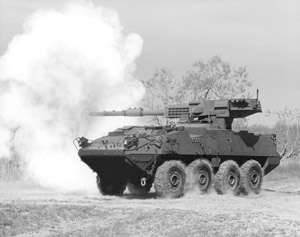 Some theorists in the late 1970s believed indeed that the existing U.S. armored park, tailored to face the Soviets in Europe, were not suited for lower overseas intensity theaters, something that was confirmed post-1990 between the Gulf war, Iraq war, and various interventions. A new armored fighting vehicle tailored for lower-intensity combat was thus design, and the LAV-25 Stryker already entering service in 1983 provided a path of improvement. Ten years later, on 1992, the Armored Gun System (AGS) program was still seen as a top priority procurement program, stating a 20-ton air-droppable light tank with an order of c300 AGS systems to equip the 82nd Airborne Division and 2nd Armored Cavalry Regiment. As said above by June 1992 FMC's M8 Armored Gun System was chosen, and cancelled in 1996 due to post-cold war budgetary constraints.
Some theorists in the late 1970s believed indeed that the existing U.S. armored park, tailored to face the Soviets in Europe, were not suited for lower overseas intensity theaters, something that was confirmed post-1990 between the Gulf war, Iraq war, and various interventions. A new armored fighting vehicle tailored for lower-intensity combat was thus design, and the LAV-25 Stryker already entering service in 1983 provided a path of improvement. Ten years later, on 1992, the Armored Gun System (AGS) program was still seen as a top priority procurement program, stating a 20-ton air-droppable light tank with an order of c300 AGS systems to equip the 82nd Airborne Division and 2nd Armored Cavalry Regiment. As said above by June 1992 FMC's M8 Armored Gun System was chosen, and cancelled in 1996 due to post-cold war budgetary constraints.
From there emerged the "Interim Armored Vehicle competition". General Dynamics Mobile Gun System, a US subsidiary for the Canadian Armoured Combat Vehicle requirement competed, in partnership with General Motors and GDLS Canada. They took a LAV-III and integrated on it the Low Profile Turret (LPT), in January 1999. This turret was an updated version of the one developed already for the failed GD–Teledyne Expeditionary Tank in the previous competition.
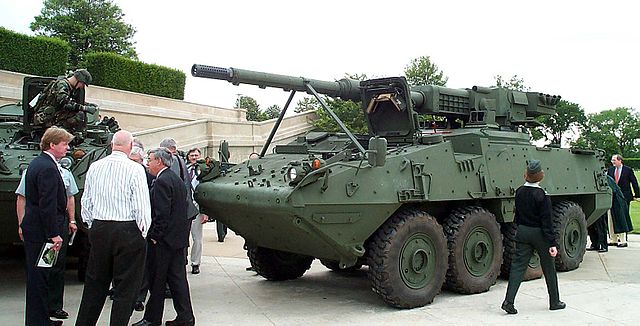
Tests of a LAV-III equipped with the MGS at the Pentagon, May 17, 2001
In October 1999, U.S. Army Chief of Staff Eric Shinseki expressed his vision for a lighter force earlier to project overseas, and calling for mid-weight brigades to link a gap between heavy armor and infantry. This led to the Interim Armored Vehicle acquisition program. Part of it became the Mobile Gun System (MGS) which for Shinseki was intended as the organic anti-armor role, but also bunkers, weapon positions and troops. GM Defense of Canada and GDLS thus submitted the LPT Assault Gun, General Dynamics being the main contractor here. Competition existed, and meanshile, United Defense LP proposed its already existing M8 Armored Gun System, plus two variants of the Mobile Tactical Vehicle Light (MTVL) including one sporting the same AGS turret sporting either a 105mm gun and 90mm guns. Two more submitted infantry carrier designs only.
MGS prototypes were not evaluated on proving grounds, which triggered protests from lawmakers and industry officials, but the Army argued that given the low procurements number, having models "to break" would be unnecessary, complicating the competition. This gruelling tests were reserved for the meat of the contracts, the infantry vehicles (M1120 Stryker family). By September 2000, the Army announced the order would be ported to 200 MGS purchased, possibly to equip additional light divisions. Two month later, it was "in the bag" for GM–GDLS, not only for the infantry carrier (5000+ vehicles expected) but also for the MGS (200). The MGS was registered in the M1120 family as the M1128. GM–GDLS at the time worked already on the IAV and amidst complaints by competitor and legal-administrative shenanigans, the deal was "saved" by late 2001.
Worst still, by January 2005, the Army ruled out sending the vehicle on the field, wating for the spare parts inventory for proper maintenance. Another report stated that the army was hoepoeful to see it depployed anyway by the summer of 2006. By October 2004, the Pentagon, reassured by a Defense Acquisition Board review approved, a further limited production of 14 vehicles, and during that time, GDLS announced it cured the ammunition handling defects. By November 2004, the Pentagon approved further low-rate production this time reevaluated to 72 vehicles, still a far cry of the 200 initially projected.
On February 2008, full-rate production was at last approved after a new Defense Acquisition Review, but the army decided to delay this and until all fixes were validated. Meanwhile, improvements were made acorss the boars. In 2010, an explosive reactive armor package, tailored for the M1128 started to be fitted on production vehicles, plus a BAR case armor. Still, no decision was made to authorize full-rate production in 2012 and by late 2013, the U.S. Army insisted on an airdroppable capability as substitute to the current MGS. This pushed GDLS' engineers to lighten up the Stryker MGS to meet the "Mobile Protected Firepower (MPF)" program requirement, but the army settled in the end on the Griffin II as seen above. In the end, with full rate production never reach, and readjustments, only 142 vehicles out of the 200 projected were ultimately delivered. By late 2016 already three M1128 MGS were reported lost in action (see later).
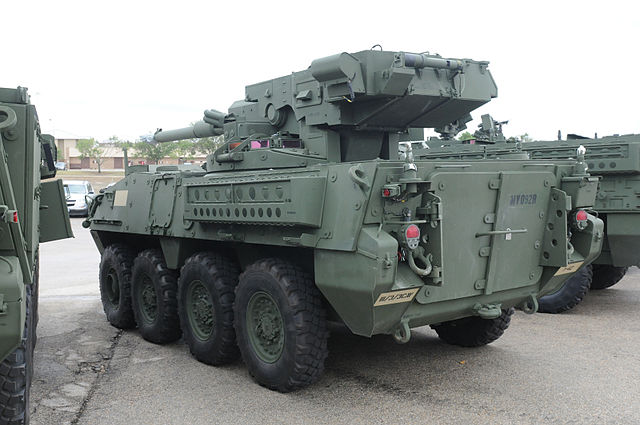
Rear of the vehicle
A Government Accounting Office report from May 2001 however expressed doubt that the vehicle would offer protection from secondary explosions and fires from the main gun ammunition anyway. As for semi-passive protection, the vehicle could be fitted with ERA blocks, as well as BAR armour against RPGs, but the wheels are not protected by side skirts. The vehicle is protected NBC as an option and had an internall spall liner and all three crew members are well within the hull. For active protection it is given a laser detector, and four sets of M6 smoke dischargers on either side of the gun mantlet. There is an Halon automatic fire suppression system in the turret basket module and engine compartment.
The main gun is supplied with only 18 rounds, 8 being pre-loaded in the small autoloader's carousel and a further 10 in a replenisher at the rear of the vehicle. Loading is automatic, at least on the field but the vehicles needs to refill with human intervention after these are spent. Rate of fire is ten rounds per minute thanks to the autoloader, thus the vehicle in high intensity combat can empty its entire ammunition supply in the matter of two minutes in sustained fire...
Ammunition types are:
-M900 kinetic energy penetrator (KEP, APFSDS) against armored vehicles
-M456A2 high-explosive anti-tank (HEAT) round for soft skin vehicles and anti-personnel fragmentation
-M393A3 high-explosive squash head plastic round (HEASH) to deal with fortifications and strong points.
-M1040 canister shot for infantry in open air.
2001 had Rheinmetall announcing a test with its own 105 mm smoothbore low recoil gun in 2004, but no report of the Army was done in this area, as already in 2000, it was found the existing 105 mm rounds stockpile in (dangerously) poor conditions, with an estimate of 50% unusable or obsolete. Production of new rounds was asked for to the industry, and effort which is still ongoing. Later was introduced the M393 high-explosive plastic (HEP-T) and M467 training round, both in 2004, by the L3 company, which would deliver some 10,000 combat and 18,400 training rounds in the coming years.
The vehicle is not all big gun and personal weapons. It has a 7.62 mm M240 machine gun usable by the gunner, whereas the commander had a deported, left side M2 Browning .50 caliber machine gun, which can be replaced by a 40 mm Mk 19 grenade launcher instead. Later some of these HMGs received a glass-still protective mask.
In May 2021, the Army announced it was to discard all its MGS systems by the end of 2022, a decision following a combat analysis about the autoloader. It was found way to expensive to maintain. This is perhaps a prevention against autoloaders that existed since decades... The other point that the M1128 could not be upgraded with a Double V-Hull as mine-IED protection measure. Last but not least another report stated that it was more cost-efficient replaced the MGC, and instead focus on lesser armament for firepower like new and promising 30 mm cannons and CROWS-J mounts for better distributed capabilities, on existing strykers instead. Plus there was a low ammunition storage, which also severly limited the MGS in the field.
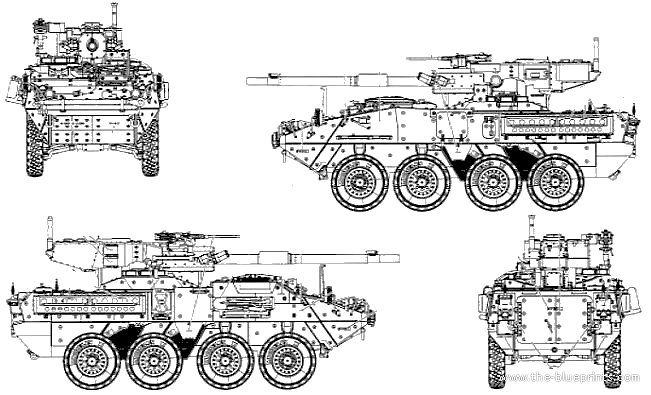
The vehicle originally designed without air conditioning forced the army to adopt "cooling vests" circulating cooled water from outside the vehicle, but this did not refreshed the vehicle itself, which suffered from computers overheating. A/C units were systematically installed in the late 2010s.
Another issue was the large weapon station and compartively very small hatch making emergency exits difficult. Also about crew safety, since the gun was essentially remote and external, any gun stoppage when firing could only be cured by personal existing the vehicle, exposed to enemy fire during the clearing. In the end, a report of 2009 pointed out the general lack of reliability of the autooader, still, excessive dead space, as well as of gun size for urban manoeuver, as well as gun control issues. Limiting the production to just 142 in 2010.
All of these and budget-related concerns eventually places successive nails in the coffing of a vehicle that served for only about a decade and compared to other systems, seems to have been "rushed" into production without a proper test campaign, but it was due mostly to its nature of interim vehicle. The real winner for now seems to be the M10 Booker.Dimensions 6.95 x 2.72 x 2.64 m (22.92 x 8.97 x 8.72 ft) Total weight, battle ready 18.77 tonnes (20.69 short tons; 18.47 long tons) Crew 3 (driver, commander, gunner) Propulsion Caterpillar C7 turbo diesel 260 kW (350 hp) 18.65 hp/ton Transmission Automatic 6 forward, 1 reverse Suspension 8×8 wheeled, torsion bars and schok absorbers, GC 15 in (38 cm) Speed (road) 60 mph (96 km/h) Range 56 US gallons (212 liters), 330 miles (528 km) Armament M68A2 105 mm cannon, 7.62 mm LMG, M240C coax HMG Armor Versus 14.5 mm AP max (0.6 in) Total 142
In late 2013, the U.S. Army, aknowleging this loss of capability with the MGS, wanted still to reintroduce an airdroppable mobile airborne protected firepower platform and since General Dynamics failed to make a light Stryker MGS for the MPF program, it went for the Griffin light tank instead, which is basically the end of the MGS program, since it's an interim vehicle. By May 2021, decision to retire all systems gradually in 2022-23 meant they would be placed either in storage or in hold to be resold. On this chapter, Canada, on a budget cut crusade, retired all its tank fleet (Leopard 1CN) by the early 2000s and planned to replace these with 66 MGS but this was ruled out in turn by 2007, Leopard 2s being aquired instead.
archive.ph
cbc.ca/news2
JSTOR Service emphasizes lighter forces: IN NEW WORLD, ARMORED GUN SYSTEM RANKS AS ARMY'S TOP PROCUREMENT PRIORITY, Richard Lardner
THE CONTENDERS: FOUR TEAMS COMPETE FOR ARMORED GUN SYSTEM CONTRACT
FMC selected to build Armored Gun System: ARMY'S AGS TO FEATURE ALL-WELDED ALUMINUM HULL, DETROIT DIESEL ENGINE
General Motors Trumpets General Dynamics Deal For Meeting IAV Requirements
Jane's armour 2011-2012, Chris Foss
Service wants to be lighter, faster, more lethal: ARMY CHIEF OF STAFF'S 'VISION' IS FOCUSED ON MEDIUM-WEIGHT FORCE, Catherine MacRae
Army Interested In Possible Buy Of 200 Additional Mobile Gun Systems
LAV variants will require some development: TESTING OF NEW INTERIM VEHICLE MAY UPSET ARMY'S FIELDING SCHEDULE, by Kim Burger
globalsecurity.org
Uparmored Bradley Could Be Tough Enough For AMPV: Testers, By Sydney J. Freedberg Jr.
Stryker Brigade Combat Team Weapons Troop, 2017
American Wheeled Armoured Fighting Vehicles, De Michael Green
Rheinmetall Offers 105mm Smoothbore Gun For Mobile Gun System Upgrade
Wikimedia commons
M551_Sheridan_replacement_process
wiki M1128_Mobile_Gun_System
This was however not a sucess, and only 142 were made from 2002 to 2010 by General Dynamics Land Systems. They are now integrated into the current Stryker brigade combat teams, but with planned retirement frpm 2022 and planned replacement by the rcent M10 Booker light tank.
Replacing the Sheridan
The Sheridan was the last tank in US inventory (until recent announcements), replacing the 1950 M41 Walker Bulldog, itself replacing the 1944 M24 Chaffee, in turn replacing the 1940 M5 and M3 Stuart. Post-ww2 saw the dereliction of both the concept of heavy tank (discontinued past 1956) but light tanks still had their own utility, well understood tactics and advantage of lower cost compared to the new main battle tanks for missions not supposed to encounter enemy armour.The 1960s replacement of the relatively classic M41 was the M551 Sheridan, an ambitious vehicle marrying light alloys for minimal protection, NBC protection, and a unique gun-missile combination based on the 6-in (152 mm), bringing unique capabilities on the battlefield thanks to its tactical (airborne) mobility. It saw good use in Vietnam, but started to be retired in 1978 when an upgrade program allowed the last M551A1s to stay long enough to soldier in the 1991 Gulf War. This was their last engagement, the remainder of the 1662 vehicles made were retired soon after, leaving the US Army with a main battle tank, the M1 Abrams, an Infantry Fightng Vehicle, the Bradley, and a 8x8 tactical APC, the Stryker (plus the HMMV). There was not equivalent of a light tank then albeit many considered the M3 Bradley (reconnaissance version) a possible stopgap.
M551 Sheridan replacement process
The Armored Gun System (AGS) was a competition organized in the 1990s for a "light tank" as stated, to replace the M551, the end of a long process started in the 1970s to provide firepower to air-mobile light infantry forces. The three primary entries were:Cadillac Gage Stingray a relatively traditional, 105 mm gun armed 4-man light tank which was not chosen and instead was adopted by the Royal Thai Army.
-FMC (M113 maker) offered the Close Combat Vehicle Light (CCVL), a three-man light tank developed also in 1983 and later "standardized" as the M8 Buford (only 6 made, leater leading to the MPF, and to the M10 Booker). -Teledyne offered the Expeditionary tank, a two-man layout with unmanned turret, perhaps a bit too advanced.
-Hägglunds US also proposed its Combat Vehicle 90 variant equipped with a tailored GIAT turret.
In 1992 however, the FMC design was selected, and six pilots of the "M8 Armored Gun System" were made. However further purchases were cancelled in 1997. Indeed, in between tactical warfare concepts evolved as the government and procurement choices, and the Stryker M1128 Mobile Gun System, based on the cheaper M1120 Stryker family of vehicles was chosen to "fill the gap", and planned to be retired in 2022. Thus in 2017, the Army requested proposals for the MPF (Mobile Protected Firepower) requirement and a BAE Systems variant of the M8 AGS and General Dynamics Land Systems (GDLS) Griffin II was chosen as a final light tank, and of BAE's proposal was dismissed by March 2022, GDLS Griffin II was retained for more developments by June 2022. 96 vehicles were planned as first batch for the fall of 2023, first expected by 2026. This is now better known as the M10 Booker, a new entry in the US Army inventory aside the M1 Abrams, that were are to cover.
The "interim solution": MGS
 Some theorists in the late 1970s believed indeed that the existing U.S. armored park, tailored to face the Soviets in Europe, were not suited for lower overseas intensity theaters, something that was confirmed post-1990 between the Gulf war, Iraq war, and various interventions. A new armored fighting vehicle tailored for lower-intensity combat was thus design, and the LAV-25 Stryker already entering service in 1983 provided a path of improvement. Ten years later, on 1992, the Armored Gun System (AGS) program was still seen as a top priority procurement program, stating a 20-ton air-droppable light tank with an order of c300 AGS systems to equip the 82nd Airborne Division and 2nd Armored Cavalry Regiment. As said above by June 1992 FMC's M8 Armored Gun System was chosen, and cancelled in 1996 due to post-cold war budgetary constraints.
Some theorists in the late 1970s believed indeed that the existing U.S. armored park, tailored to face the Soviets in Europe, were not suited for lower overseas intensity theaters, something that was confirmed post-1990 between the Gulf war, Iraq war, and various interventions. A new armored fighting vehicle tailored for lower-intensity combat was thus design, and the LAV-25 Stryker already entering service in 1983 provided a path of improvement. Ten years later, on 1992, the Armored Gun System (AGS) program was still seen as a top priority procurement program, stating a 20-ton air-droppable light tank with an order of c300 AGS systems to equip the 82nd Airborne Division and 2nd Armored Cavalry Regiment. As said above by June 1992 FMC's M8 Armored Gun System was chosen, and cancelled in 1996 due to post-cold war budgetary constraints.
From there emerged the "Interim Armored Vehicle competition". General Dynamics Mobile Gun System, a US subsidiary for the Canadian Armoured Combat Vehicle requirement competed, in partnership with General Motors and GDLS Canada. They took a LAV-III and integrated on it the Low Profile Turret (LPT), in January 1999. This turret was an updated version of the one developed already for the failed GD–Teledyne Expeditionary Tank in the previous competition.

Tests of a LAV-III equipped with the MGS at the Pentagon, May 17, 2001
In October 1999, U.S. Army Chief of Staff Eric Shinseki expressed his vision for a lighter force earlier to project overseas, and calling for mid-weight brigades to link a gap between heavy armor and infantry. This led to the Interim Armored Vehicle acquisition program. Part of it became the Mobile Gun System (MGS) which for Shinseki was intended as the organic anti-armor role, but also bunkers, weapon positions and troops. GM Defense of Canada and GDLS thus submitted the LPT Assault Gun, General Dynamics being the main contractor here. Competition existed, and meanshile, United Defense LP proposed its already existing M8 Armored Gun System, plus two variants of the Mobile Tactical Vehicle Light (MTVL) including one sporting the same AGS turret sporting either a 105mm gun and 90mm guns. Two more submitted infantry carrier designs only.
MGS prototypes were not evaluated on proving grounds, which triggered protests from lawmakers and industry officials, but the Army argued that given the low procurements number, having models "to break" would be unnecessary, complicating the competition. This gruelling tests were reserved for the meat of the contracts, the infantry vehicles (M1120 Stryker family). By September 2000, the Army announced the order would be ported to 200 MGS purchased, possibly to equip additional light divisions. Two month later, it was "in the bag" for GM–GDLS, not only for the infantry carrier (5000+ vehicles expected) but also for the MGS (200). The MGS was registered in the M1120 family as the M1128. GM–GDLS at the time worked already on the IAV and amidst complaints by competitor and legal-administrative shenanigans, the deal was "saved" by late 2001.
Production and issues
Despite the contract was signed, issues to produced the MGS accumulated. The delivery date slipped two years, until November 2003 and the Army allowed GM–GDLS to substitute its M1134 Stryker ATGM variant for the MGS as an interim measure. This was contested by UDLP, but to no avail. The first eight pre-production vehicles were at last ready as annoubced by July 2002 and went for field testins. By March 2004, the transfer of four to the 82nd Airborne Division deployed in Iraq was approved by the army as a supreme test of confidence and by June 2004 but this was suspended, wating to meet the 82nd's requirements. August saw the first air-drop test, not of the MGS, but of a a Stryker M1132 Engineer Squad Vehicle "stuffed" to reproduce the weight of a combat ready MGS. The Army identified issues in this capability as the M1128 was the heavier of the family, whereas problems multiplied with the autoloader.Worst still, by January 2005, the Army ruled out sending the vehicle on the field, wating for the spare parts inventory for proper maintenance. Another report stated that the army was hoepoeful to see it depployed anyway by the summer of 2006. By October 2004, the Pentagon, reassured by a Defense Acquisition Board review approved, a further limited production of 14 vehicles, and during that time, GDLS announced it cured the ammunition handling defects. By November 2004, the Pentagon approved further low-rate production this time reevaluated to 72 vehicles, still a far cry of the 200 initially projected.
On February 2008, full-rate production was at last approved after a new Defense Acquisition Review, but the army decided to delay this and until all fixes were validated. Meanwhile, improvements were made acorss the boars. In 2010, an explosive reactive armor package, tailored for the M1128 started to be fitted on production vehicles, plus a BAR case armor. Still, no decision was made to authorize full-rate production in 2012 and by late 2013, the U.S. Army insisted on an airdroppable capability as substitute to the current MGS. This pushed GDLS' engineers to lighten up the Stryker MGS to meet the "Mobile Protected Firepower (MPF)" program requirement, but the army settled in the end on the Griffin II as seen above. In the end, with full rate production never reach, and readjustments, only 142 vehicles out of the 200 projected were ultimately delivered. By late 2016 already three M1128 MGS were reported lost in action (see later).
Design of the M1128 MGS
Hull design, armour and protection
The MGS is essentially a standard M1120 vehicle, with an adapted central module to house the turret basker proper to the MGS system. The turret itself is "semi-remote", with the commander and gunner located in the turret basket, making some good separation from the ammunition bin above. Protection was made of RHA steel about 10 mm all around, offering protection at all angles against 14.5 mm AP rounds.
Rear of the vehicle
A Government Accounting Office report from May 2001 however expressed doubt that the vehicle would offer protection from secondary explosions and fires from the main gun ammunition anyway. As for semi-passive protection, the vehicle could be fitted with ERA blocks, as well as BAR armour against RPGs, but the wheels are not protected by side skirts. The vehicle is protected NBC as an option and had an internall spall liner and all three crew members are well within the hull. For active protection it is given a laser detector, and four sets of M6 smoke dischargers on either side of the gun mantlet. There is an Halon automatic fire suppression system in the turret basket module and engine compartment.
Armament
The MGS is given a relatively low profile turret with small silhouette, especially seen from forward. It is stabilized, using the standard 105mm M68A1E4 rifled cannon shared by the late M60, complete with fume extractor and autoloader. This gun is mainly aimed at offering ground support with HE and frag shell for infantry, not engaging tanks, albeit some APFDS or HEAT rounds could be carried depending on the mission. It was understood it could and should never engage main battle tanks given its total absence of protection.The main gun is supplied with only 18 rounds, 8 being pre-loaded in the small autoloader's carousel and a further 10 in a replenisher at the rear of the vehicle. Loading is automatic, at least on the field but the vehicles needs to refill with human intervention after these are spent. Rate of fire is ten rounds per minute thanks to the autoloader, thus the vehicle in high intensity combat can empty its entire ammunition supply in the matter of two minutes in sustained fire...
Ammunition types are:
-M900 kinetic energy penetrator (KEP, APFSDS) against armored vehicles
-M456A2 high-explosive anti-tank (HEAT) round for soft skin vehicles and anti-personnel fragmentation
-M393A3 high-explosive squash head plastic round (HEASH) to deal with fortifications and strong points.
-M1040 canister shot for infantry in open air.
2001 had Rheinmetall announcing a test with its own 105 mm smoothbore low recoil gun in 2004, but no report of the Army was done in this area, as already in 2000, it was found the existing 105 mm rounds stockpile in (dangerously) poor conditions, with an estimate of 50% unusable or obsolete. Production of new rounds was asked for to the industry, and effort which is still ongoing. Later was introduced the M393 high-explosive plastic (HEP-T) and M467 training round, both in 2004, by the L3 company, which would deliver some 10,000 combat and 18,400 training rounds in the coming years.
The vehicle is not all big gun and personal weapons. It has a 7.62 mm M240 machine gun usable by the gunner, whereas the commander had a deported, left side M2 Browning .50 caliber machine gun, which can be replaced by a 40 mm Mk 19 grenade launcher instead. Later some of these HMGs received a glass-still protective mask.
Known issues
The MGS, being a derivative of Canadian Army vehicles, had as requirement to be air transportable in a C130 Hercules, which the U.S. Army had not. The design was to be changed to lower the MGS's height to fit inside and the solution found was to lower it within the hull, which causes issues, notably of reducing distance between the muzzle brake and hull, and blast overpressures. The solution was the installation of a "pepper pot" covered by a metal sheating.In May 2021, the Army announced it was to discard all its MGS systems by the end of 2022, a decision following a combat analysis about the autoloader. It was found way to expensive to maintain. This is perhaps a prevention against autoloaders that existed since decades... The other point that the M1128 could not be upgraded with a Double V-Hull as mine-IED protection measure. Last but not least another report stated that it was more cost-efficient replaced the MGC, and instead focus on lesser armament for firepower like new and promising 30 mm cannons and CROWS-J mounts for better distributed capabilities, on existing strykers instead. Plus there was a low ammunition storage, which also severly limited the MGS in the field.

The vehicle originally designed without air conditioning forced the army to adopt "cooling vests" circulating cooled water from outside the vehicle, but this did not refreshed the vehicle itself, which suffered from computers overheating. A/C units were systematically installed in the late 2010s.
Another issue was the large weapon station and compartively very small hatch making emergency exits difficult. Also about crew safety, since the gun was essentially remote and external, any gun stoppage when firing could only be cured by personal existing the vehicle, exposed to enemy fire during the clearing. In the end, a report of 2009 pointed out the general lack of reliability of the autooader, still, excessive dead space, as well as of gun size for urban manoeuver, as well as gun control issues. Limiting the production to just 142 in 2010.
All of these and budget-related concerns eventually places successive nails in the coffing of a vehicle that served for only about a decade and compared to other systems, seems to have been "rushed" into production without a proper test campaign, but it was due mostly to its nature of interim vehicle. The real winner for now seems to be the M10 Booker.
M1128 MGS specifications
Combat use and fate
The Mobile Gun System was deployed with the new mobile Stryker brigades in the Iraq War and in Afghanistan, where three were lost in action, notably due to IEDs and mines. They operated with BAR armor but not ERA blocks. The way the vehicle was organized, as originally projected was to allocate at first 34 per brigade, but it was later reduced to 9 MGS, 3 per infantry company, to a battalion, so a total of 27 per "Stryker brigade". This was however in 2013, and issues with the vehicle to 10. By May 2017, the Stryker brigade combat team comprised three platoons of MGS Strykers completed by three of ATGM Strykers to keep and artillery and anti-tank capability side by side. In the end a four-vehicle MGS platoon could be used semi-independently within a Stryker infantry company, and one more MGS in support of a Stryker infantry platoon.In late 2013, the U.S. Army, aknowleging this loss of capability with the MGS, wanted still to reintroduce an airdroppable mobile airborne protected firepower platform and since General Dynamics failed to make a light Stryker MGS for the MPF program, it went for the Griffin light tank instead, which is basically the end of the MGS program, since it's an interim vehicle. By May 2021, decision to retire all systems gradually in 2022-23 meant they would be placed either in storage or in hold to be resold. On this chapter, Canada, on a budget cut crusade, retired all its tank fleet (Leopard 1CN) by the early 2000s and planned to replace these with 66 MGS but this was ruled out in turn by 2007, Leopard 2s being aquired instead.
& resources
Stryker Combat Vehicles by Gordon L. Rottman, Bloomsbury Publishing Plc, 20 sept. 2012archive.ph
cbc.ca/news2
JSTOR Service emphasizes lighter forces: IN NEW WORLD, ARMORED GUN SYSTEM RANKS AS ARMY'S TOP PROCUREMENT PRIORITY, Richard Lardner
THE CONTENDERS: FOUR TEAMS COMPETE FOR ARMORED GUN SYSTEM CONTRACT
FMC selected to build Armored Gun System: ARMY'S AGS TO FEATURE ALL-WELDED ALUMINUM HULL, DETROIT DIESEL ENGINE
General Motors Trumpets General Dynamics Deal For Meeting IAV Requirements
Jane's armour 2011-2012, Chris Foss
Service wants to be lighter, faster, more lethal: ARMY CHIEF OF STAFF'S 'VISION' IS FOCUSED ON MEDIUM-WEIGHT FORCE, Catherine MacRae
Army Interested In Possible Buy Of 200 Additional Mobile Gun Systems
LAV variants will require some development: TESTING OF NEW INTERIM VEHICLE MAY UPSET ARMY'S FIELDING SCHEDULE, by Kim Burger
globalsecurity.org
Uparmored Bradley Could Be Tough Enough For AMPV: Testers, By Sydney J. Freedberg Jr.
Stryker Brigade Combat Team Weapons Troop, 2017
American Wheeled Armoured Fighting Vehicles, De Michael Green
Rheinmetall Offers 105mm Smoothbore Gun For Mobile Gun System Upgrade
Wikimedia commons
M551_Sheridan_replacement_process
wiki M1128_Mobile_Gun_System
Gallery
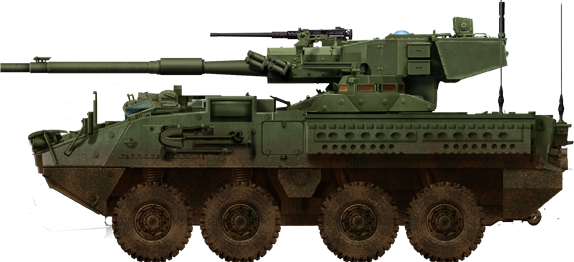
M1128 illustration
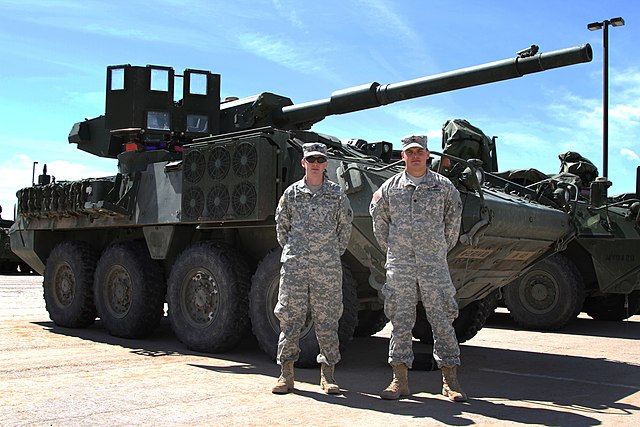
M1128 frim Company B, 4th Batallion, 9th Infantry Regiment, 1st Stryker Brigade Combat Team, 4th Infantry Division
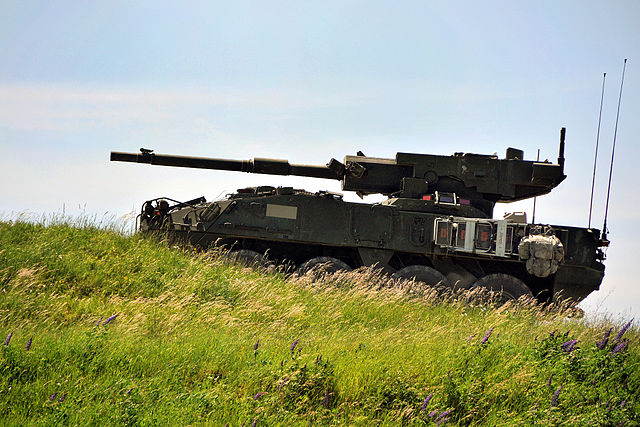
M1128 at the Grafenwoehr Training Area, Germany May 25, 2012
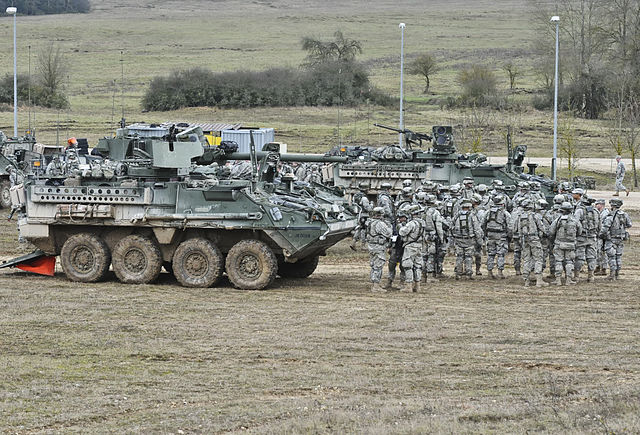
M1128 at Allied Spriti Day 2018
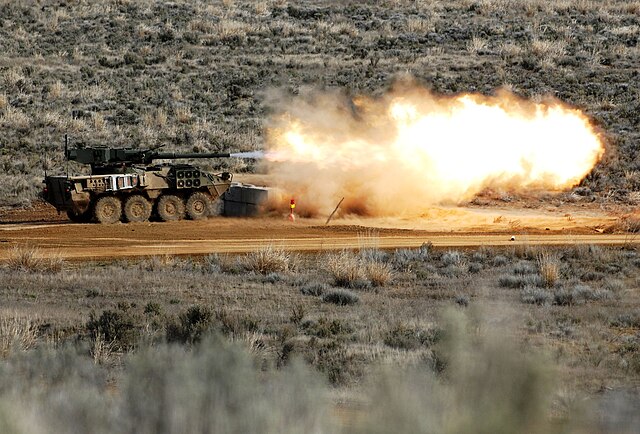
M1128 MGS at the US Army Range
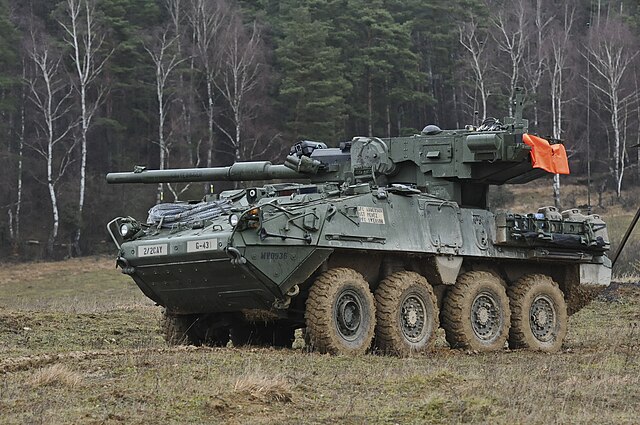
Exercize Allied Spirit Day
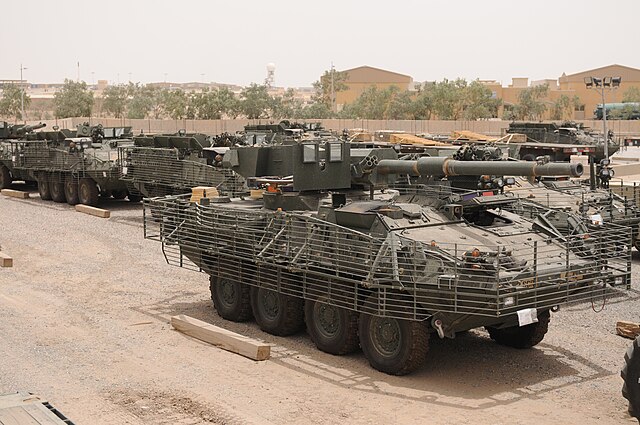
3rd Army Stryker sent to Afghanistan M1128 with BAR armor
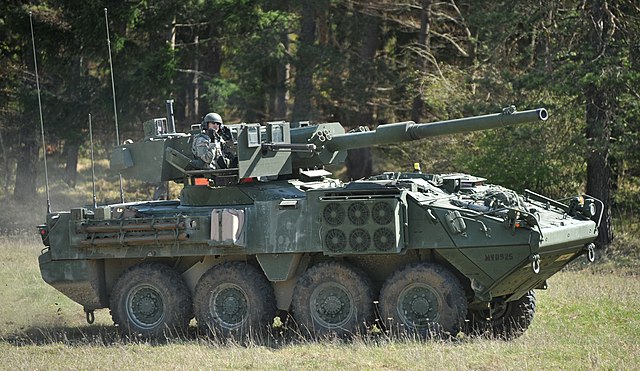
M1128 Stryker MGS assigned to Apache Co. 1st Sqn. 2nd Cav. Regiment 2012
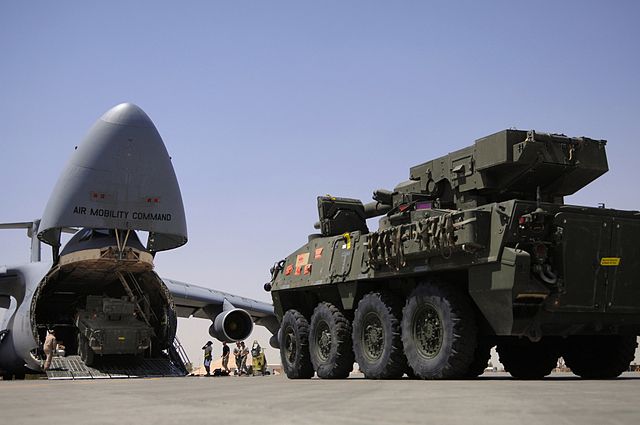
M1128 being airlifted on a C5 galaxy
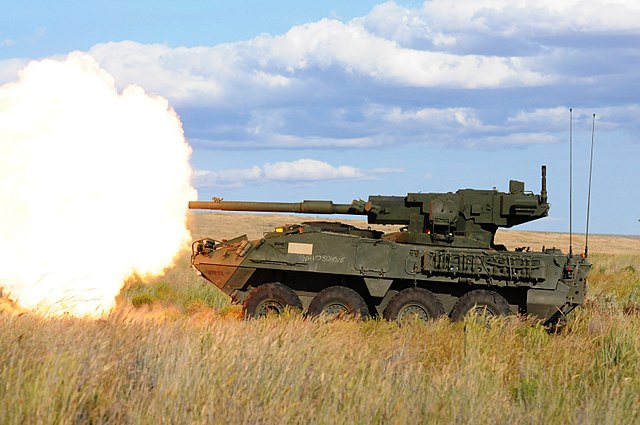
Crews qualified on the MGS at Yakima Training Center, Washington, 1st Bat. 17th Infantry Regiment
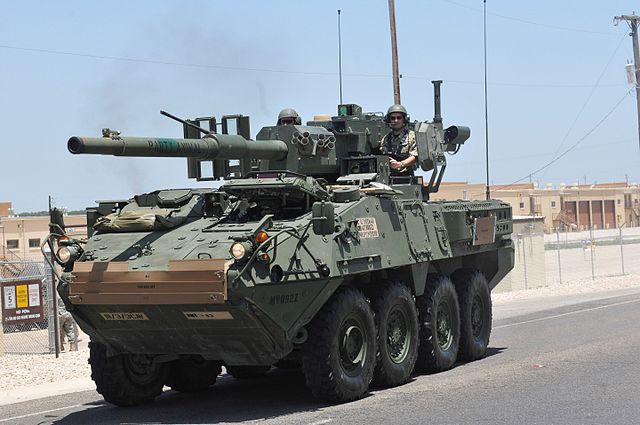
"Brave Rifles" assisting a British attaché in Afghanistan

Modern Tanks
Modern MBTs posters

Denel Bagder (2018)

Type 16 MCV (2016)

Gepard 1A2 last rounds 2011

SANDF

Russian AFVs

Main Battle Tanks
